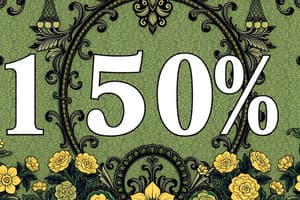Podcast
Questions and Answers
What is the primary goal of the Loss Leader Strategy?
What is the primary goal of the Loss Leader Strategy?
- To offer products at a loss without attracting customers
- To attract customers who will buy other items (correct)
- To increase prices on all items in the store
- To sell popular items at a high price
How do discounts and sales differ?
How do discounts and sales differ?
- Discounts are only applicable to new products, while sales apply to older products
- Discounts are offered during specific seasons, while sales occur throughout the year
- Discounts are temporary, while sales are permanent price reductions
- Sales are temporary, while discounts can occur year-round (correct)
What type of consumers do loyalty programs typically reward?
What type of consumers do loyalty programs typically reward?
- Frequent shoppers (correct)
- New shoppers
- Random shoppers
- Infrequent shoppers
How do subscription services like Netflix use discounts?
How do subscription services like Netflix use discounts?
What is the purpose of dynamic pricing for retailers?
What is the purpose of dynamic pricing for retailers?
When might a retailer temporarily increase the price of a product?
When might a retailer temporarily increase the price of a product?
What is the formula for calculating a percentage discount?
What is the formula for calculating a percentage discount?
If an item costs $75 and you receive a 15% discount, what is the discounted price?
If an item costs $75 and you receive a 15% discount, what is the discounted price?
What is the purpose of bundling as a discount strategy?
What is the purpose of bundling as a discount strategy?
What is the difference between a discount and a sale?
What is the difference between a discount and a sale?
In the example given, if an item is regularly priced at $50 and you receive a 20% discount, what is the discount amount?
In the example given, if an item is regularly priced at $50 and you receive a 20% discount, what is the discount amount?
What is a common application of discounts in retail?
What is a common application of discounts in retail?
If an item is originally priced at $80 and you receive a 25% discount, what is the discounted price?
If an item is originally priced at $80 and you receive a 25% discount, what is the discounted price?
What is the purpose of offering discounts from a retailer's perspective?
What is the purpose of offering discounts from a retailer's perspective?
Which of the following is NOT a discount strategy mentioned in the text?
Which of the following is NOT a discount strategy mentioned in the text?
If an item is originally priced at $120 and you receive a 30% discount, what is the discounted price?
If an item is originally priced at $120 and you receive a 30% discount, what is the discounted price?
Flashcards are hidden until you start studying
Study Notes
Financial Discounts: Calculations, Strategies, Applications, and Comparisons with Sales
Discounts have become a popular marketing tool used by retailers to attract customers and boost sales. They come in various forms and can significantly affect the price of goods and services. In this article, we will discuss financial discounts, including how they are calculated, strategies for their application, differences between them and sales, and their real-life applications.
Calculating Discounts
The calculation of discounts is straightforward. It's simply the reduction of a product's price when it's sold at a lower amount. For example, if an item is normally priced at $50 and you receive a 20% discount, the new price would be $40.
Percentage discounts can be calculated by following this formula:
Discount Amount = Original Price * Discount Rate
Here's an example:
If an item is regularly priced at $50 and you receive a 20% discount, the discount amount would be:
$50 * 20% = $10
So, you would pay $40 after the discount.
Discount Strategies
Retailers employ several strategies when offering discounts to optimize their profits. Some common tactics include:
Bundling
Bundling involves selling multiple items together at a lower cost than if purchased individually. This strategy encourages consumers to buy more than they might otherwise, increasing the store's overall revenue.
Example: Instead of paying $75 for three shirts separately, you could get them all for just $60 through bundling.
Dynamic Pricing
Dynamic pricing adjusts product prices based on market trends, demand, and competition. This strategy allows retailers to maximize their sales by setting prices that align with consumer preferences and demand fluctuations.
Example: If a product's popularity spikes, the price may temporarily increase due to high demand; otherwise, the price would decrease when demand falls.
Loss Leader Strategy
In this strategy, a store offers a popular item at a very low price, even if it results in a loss for the vendor. The goal is to attract customers who will then purchase other items from the store, increasing overall revenue.
Example: A computer store might sell laptops significantly below cost, hoping that shoppers will also buy accessories like printers, cases, or extended warranties.
Discount vs Sale
While discounts and sales are both forms of pricing strategies, they differ fundamentally. Sales represent temporary reductions in product prices usually offered during specific seasons or events, such as holiday sales or end-of-season clearances. On the other hand, discounts can occur throughout the year whenever products reach a certain markdown level.
Discount Applications
Discounts are commonly applied across various industries and scenarios. Here are some examples of discount types and their applications:
Loyalty Programs
Loyalty programs reward frequent shoppers with exclusive discounts and perks. For instance, companies like Amazon Prime offer members free two-day shipping and access to special deals unavailable to non-members.
Subscription Services
Subscription services such as Netflix often provide initial discounts to attract new subscribers. These promotional offers may later expire, transitioning into regular subscription rates.
In conclusion, understanding financial discounts is crucial for both businesses and consumers. By knowing how discounts are calculated, what strategies are used to apply them, and their comparison with sales, players in the market can make informed decisions.
Studying That Suits You
Use AI to generate personalized quizzes and flashcards to suit your learning preferences.




